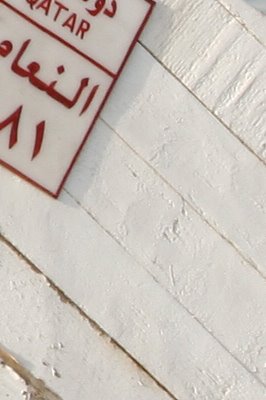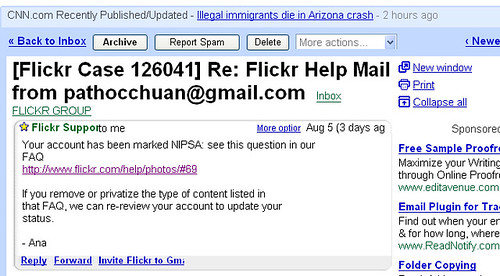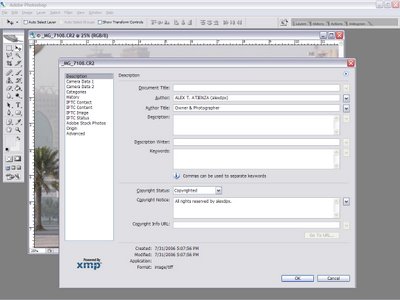“Flickr” sounds like an unusual word to me when I think of photosharing. Some neat words like “Photonline,” “Photobase,” or “Pixibit” sound more likely palatable to the ear. July marks my 6th month in Flickr.com, after 1200 photos and roughly the same amount of photos I have commented on. And I have already formed my strong opinions about things related to Photography.
How I came to know about Flickr
About two years ago, some fellow members of our company’s photo club, of which I am a member of, invited me to share photos at Pbase.com. However, I felt a year of digital photography wasn’t enough experience for me to have been able to capture great photos. So, I excused myself saying that I wouldn’t want my photos “stolen” by digital thieves. Several months later, I joined the first photo contest in our company and won 3rd prize. Practically, that was the first “return on invesment” I was able to earn. It wasn’t big a price but it made me start thinking maybe it could just happen to me too that I’d be making money from the things I love doing best.
Not too long fter that first win, I did my first photo job and to my delight, the client loved my output! Thus, I gained confidence and shot several more engagements followed. Because of such engagements, I thought that I should also think of a brand for my photos, one that catches the ear but not cheesy. I eventually came up with “rarerimages,” to represent my photos which are capture intuitively and creatively composed. It has also my initials, R.E.R.
Late last year, a fellow company club member mentioned about two National Geographic photo contests, I joined both and one of my creative photos became a top 20 finalist, which was my goal as my objective was to field my photos to see how it would fair against those of others. Top 20 represents a quantum leap of and achievement for me.
My experience creating account, choosing buddy icon, and posting first photo
With these I thought I am already ready to share my photos. Again, fellow company club members—
Stan and
John Edward (JE)--approached me and told me to share my photos for exposure, and to try Flickr.com. I created my account and named my photo domain (what else, but) “rarerimages by shutterbugrer.” Next comes the hard part of choosing a buddy icon. To be different, I choose one that represents light in Photography, and that also is composed of primary colors (the basis for all other colors). I found my sunset photo of Fort Bonifacio which has a light arrow coming out of a dark cloud obscuring the sun. It has all the characteristics I wanted. It has been my buddy icon ever since, never changing it even for a brief period. It was however, several days before I uploaded photos since I first checked what kind of photos are seen in Flickr, and also it was not easy to choose what to upload from my stock photos.
My feelings when my photos are being faved and commented on
What was the very first photo I uploaded? Now, that I don’t recall since it was a batch of photos I sent the first time and already have deleted several earlier ones when my account wasn’t yet “pro” and was limited to 200 photos for viewing. But my first comments and faves came, naturally from Stan and JE. Those comments were really encouraging, although brief most of the times. They gave fuel to my “flickring” and eventually to my Photography, as I already began to think of capturing better photos for co-flickristas’ viewing and commenting (as well as dissing) pleasure. I was taught to be always grateful for favors received and so, to show my appreciation I reciprocated most comments. (By May 11 this year, I made it a personal rule to always reciprocate on comments as soon as possible.)
Eventually my lunch break became shorter and my noon nap after lunch disappeared, replaced by uploading and commenting and exploring and posting on discussion threads. Slowly my contacts built up. At first, I tag people from discussion threads my contacts; some reciprocate, some don’t. Later on, I found that with my limited time on the internet, I can’t keep up looking at fresh photos of my contacts so I slowed the contact build up by being selective of whom to make as my contacts.
The effects of Flickr.com on me as:
Everything that one comes in contact with regularly in the course of his daily routine must have profound impact on someone.
- a Photographer
Flickr has elevated my skills as a photographer to higher levels. I am more conscious about about how I to compose my captures, although I have not departed from my flair of catching subjects with a different point of view. On the contrary, now that I am conscious of how photos may be very similar when shot at same angles, I would think of ways how my angles would be different from others, without sacrificing content. That reads easier than done, especially when the general norm appears to be “go with the mainstream,” not venturing into the unknown for fear that it will be unpleasant. It’s a risk I took because I understand that to be “rarer” necessarily means to be different, even radically different.
Someone said that if I don’t take up Photoshop, “I’ll just be sorry.” I just laughed at it and secretly pitied the individual who said it. Although I am not against Photoshop and similar image-enhancing/altering software, I just don’t have the time right now. I’ve done some Photoshop editing just to see the features. Having done so, I agree that such a very powerful tool has extreme potentials--to either bring out the best in a photo or take away the skills of the photographer. In the future, if I would need it, I know I can master it and be very good at it too. How I would do that without compromising my Photography skills would be the real challenge.
One could attend seminars and workshops by some photographers. I believe that such process represents a “transfer of knowledge,” and by comparison, it rings of mere “copy, paste,” the perfect path to the mainstream, from which only a few manage to wrestle out of to spouse their own personal style. And don’t expert resource persons in such workshops have their “trade secrets?” Do you expect them, by grace, to share their most guarded ones to many? Often, striving Photographers uncover those secrets by their own.
By not joining the mainstream, I know I could be foregoing “tickets” to popularity. That I do recognize and always keep in mind. But I also know that something popular is not the same as that which endures. I prefer the latter. I have pledged that I will not copy someone else’s style and therefore I am relying on myself to learn by my own mistakes and advance my personal style according to my pace and artistic disposition.
- an Office Worker
Anyone who loves Photography wants freedom, to roam and to find subjects in the real world—be that they may be the real life scattered about in the streets and the damp dungeons of poverty, or beauty in the studios or nature. He wants also the freedom to interpret these through the images he captures. And most importantly, he wants the freedom to share this to all who respects life and wonders at the beauty and variety of divine creation.
The shackles of the four walls enclosing a Photographer are frequently bound to be loosened, and the walls themselves dissolved, sooner or later. Figuratively, he has to die doing what he loves best, or he will die humiliated, the cause of which is the lack of freedom.
- a Social Person
Socially speaking, I have gained more “friends” and have come in contact with fellow shutterbugs who share the same passion as mine. And the Club I have joined—the Flickers Photo Club (FPC)—appears to be a very good venue at honing my skills at various Photographic themes. “Experience is the best teacher” and I have promised myself that I will be good at outdoor and indoor photography. Thus, I do not loosely pass on the opportunity to practice my shooting, with the Club or just on my own.
Although sharing the same passion, each Photographer has his own identity and therefore has unique preferences. This universal truth one must acknowledge to become part of a community, a constructive contributor and not as an intolerant divider. I have accepted that truth long before I have taken the camera into my hand, and have strived to always strike a balance between mingling with people and controlling myself to be always positive and open-minded. Everything has bounds, and have recognized that too and therefore, there are just some people, places and events that I will not allow to erode from my integrity.
- a Family Man
In Photography, like any other endeavors in life, perhaps, the very first people one has to commune with must be his family. I have made it clear to my wife and relatives that no matter what, in reasonableness, I will not give up on something that has become a dear part of my life. I have made them come to terms with the fact that this art brings me joy, a joy comparable to those experienced when a marriage gets tied, a baby is born, or a long-gone loved one comes back home. And reasonableness has no room for dictatorship. Sometimes, a family event will prevent you from attending a shoot. That’s ok, you get the same joy. A family member gets sick, but that’s ok, because by cooperating to help the sick get well, you get the same joy. In fact, didn’t Jesus say we get more happiness from giving that receiving? (Acts 2:35) And by being reasonable, the principle of reciprocity will work to one’s good, as it does to mine, because you get “tickets” to go out and shoot! It’s a win-win situation.
What have I learned during the past 6 months?
- About Flickr.com
Flickr definitely is the best place to stay if you care to share your photographs and socialize with fellow shutterbugs. I’ve explored not much of the whole of its universe, but with the time I have in my hands for it, I have seen and read enough to know that it serves almost all my needs for ‘storing, searching, sorting, and sharing’ photos. I’ve read in Time magazine how Stewart Butterfield and Caterina Fake founded Flickr from a simple idea taken from a workmate. What this couple did later proveds to be a big favor for all Photo enthusiasts—pro and amateur alike. And what works the present owners have yet in progress are surely laudable.
Thus, whatever they earn out of doing this, they deserve. It’s only unfortunate that like all systems, it is not hack- and spamproof. It also has defects that affected and dismayed some of my Flickr friends—Pat Hocchuan, being the latest—because it’s apparent that some defects is related to the prime factors why users chose Flickr. But besides these inevitable downsides, Flickr is the photo site I would endorse.
- About other Flickr.com users
Most of Flickr users I know are friendly, and are amiable in both their critiques and opinions. At least that’s what I can tell from their comments and posts. Generally, people strive for higher ideals, but seldom such efforts are seen and given recognition. Therefore, I take my hats of to Flickristas who always believe in the good and always see positive things in photos! Unfortunately, there are those who dwell on the other side of the fence.
Probably the most important lesson I learned about being a Photographer using Flickr is that a Photographer’s character matters more than his Photography. Loud, aggressive, and inconsiderate people taught me this. Reading their comments and opinions on discussion threads vexes my spirit and I’m sure that of others, too. Thus, I avoid them, rarely giving a glance even on their buddy icons, or their photos for that matter. Call that bias, but how could anyone ever have something to do with anything that affects one negatively? Because one has advance to professional levels does not give one the license to throw weight around as if everyone and every other photo is inferior to them and their photos.
- About my skills as a Photographer
As for myself, I am always of the recognition that much about photography will remain out of my reach. My skills I will consider always “amateur.” Someone said in a discussion in the Philippines group: “Amateur for life.” I believe that was Geproks. Well put, and amateur for life I will be—always learning, always reaching for a higher level, but never attaining a “top,” a peak of expertise. I always experiment—I love doing it—to find, not a “Holy Grail,” but a tool for self-expression and be “differently pleasant.”
I guess the most important “law” one has to live by in Flickr is: “Photography is fun.” I found that this has helped me cope with failures, disappointments and disenchanments. Believing thus, insofaras as it depends on me, I make every photo event fun. Therefore, while striving to shoot differently, thinking “fun” keeps me away from the pitfall of missing some great moments because one is engrossed too much on the details of another subject, which to most eyes, is mundane (there are only so much “professionals” to notice it anyway).
“Fun” also helps me maintain a healthy outlook by not taking things seriously. For example, by not giving “Interestingness” too much credit, neither do I push myself to tag so many people as contacts (who could possibly fave-tag and comment on my photos) nor join so many groups to where I would post my photos. Thus, I save myself from the snare of spending unreasonable amounts of time on Flickr reading comments, reciprocate (as a rule, I reciprocate comments “one-to-one,” but frequently I do a “two-to-one”), and keeping track of comments I made, beyond what my circumstances allow.
If I could fire or fuel the interest of several who visit my photos, that is great because that is what I wanted. If I could keep even just 20 contacts coming back to my photostream, that is a tremendous feat for me, because I don’t expect to affect that much people. If I could make two or three write a testimonial for me, I’d say I have already achieved a monumental accomplishment.
I like to keep things personal, which does favors to my friends and me.
What is my resolved after my 6 months with Flickr.com?
After six months of using Flickr, my resolve is to keep things in and around my Flickr space fun, strive to be pleasantly different, and keep things interesting. I also resolve to not allow so much influence on my Photography so as to lose my own style. Moreover, as my time in Flickr would permit, I will be discreet in adding contacts and joining groups.
I recognize that self-imposed rules are the hardest to keep and the easiest to break. Self-discipline has to have control if I want to keep at level with my personal Flickr rules that took effect last May 11. I know that self-respect suffers if I violate one of these rules, and lack of self-respect drives people to various shenanigans and insanities. Therefore, I resolved to continue guarding myself from violating the rules, in recognition of their importance to keeping personal and fair dealings with my contacts, a balanced use of this excellent site, and my own sanity. These are my rules, previously 5 but I have collapse previous rules 2 and 3 into just rule 2, and updated rule 4 (formerly rule 5) to include viewing of Contact-Friends’ latest photos:
1 – Reciprocity. Comment on my pic, I'll do the same with yours, a.s.a.p.
2 – Honesty and Integrity. I will not lie about my work and I will make not make patronizing or flattering comments.
3 - Respectful Treatment. I will not deliberately put down others.
4 - Contribute Constructively. I will view the latest (at least, first page) photos of, at least, three of my Contacts and two of my Contact-Friends and comment on good ones, weekly.
Let’s Flickr!
 Canon EOS 400D / Rebel XTi. Front View. Read the Canon White Paper.
Canon EOS 400D / Rebel XTi. Front View. Read the Canon White Paper.












